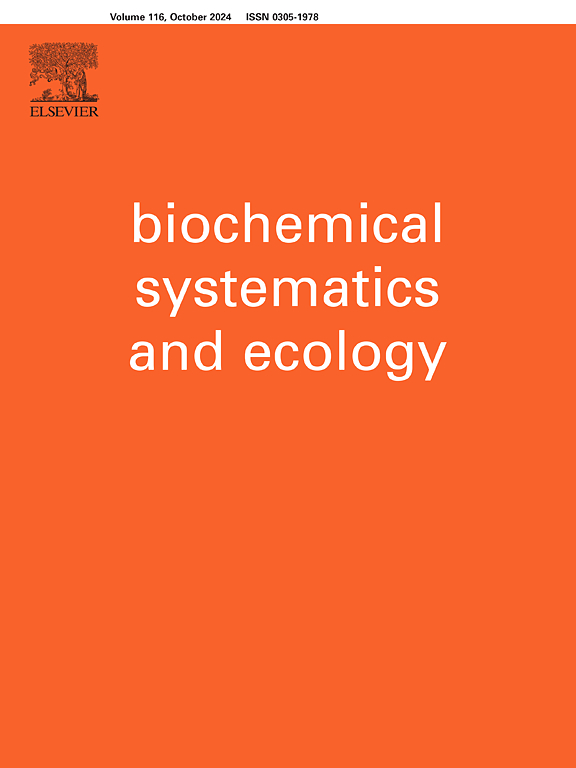菝葜中新的2-芳基苯并呋喃衍生物及其化学分类意义
IF 2
4区 生物学
Q4 BIOCHEMISTRY & MOLECULAR BIOLOGY
引用次数: 0
摘要
本研究从菝葜根茎中分离得到1个2-芳基苯并呋喃衍生物(1)、3个二苯乙烯(2-4)、3个苯乙酮苷(5-7)、3个苯丙素(8-10)和8个黄酮类化合物(11-18)。核磁共振光谱分析了它们的结构,并与先前报道的数据进行了比较。化合物1、5 ~ 7、10、18均为首次从菝葜中分离得到。采用CCK-8法检测化合物对HeLa细胞的细胞毒活性,其中化合物4的IC50值最高,为34.81±1.50 μg/mL。进一步研究发现化合物4对HeLa细胞的细胞毒作用与细胞凋亡和细胞周期有关。此外,还讨论了分离化合物的化学分类意义。本文章由计算机程序翻译,如有差异,请以英文原文为准。

A new 2-arylbenzofuran derivative and other constituents from Smilax china L. and their chemotaxonomic significance
One previously undescribed 2-arylbenzofuran derivative (1), three stilbenes (2-4), three acetophenone glycosides (5–7), three phenylpropanoids (8–10), and eight flavonoids (11–18) were isolated from the rhizome of Smilax china L. in this study. NMR spectra elucidated their structures and were compared with previously reported data. Compounds 1, 5–7, 10, and 18 were identified for the first time in Smilax china L. The cytotoxicity of the isolated compounds was detected on HeLa cells by the CCK-8 method, and compound 4 was found to possess the highest cytotoxic activity with an IC50 value of 34.81 ± 1.50 μg/mL. Further studies revealed that the cytotoxic effect of compound 4 on HeLa cells was related to apoptosis and the cell cycle. In addition, the chemotaxonomic significance of the isolated compounds was discussed.
求助全文
通过发布文献求助,成功后即可免费获取论文全文。
去求助
来源期刊

Biochemical Systematics and Ecology
生物-进化生物学
CiteScore
3.00
自引率
12.50%
发文量
147
审稿时长
43 days
期刊介绍:
Biochemical Systematics and Ecology is devoted to the publication of original papers and reviews, both submitted and invited, in two subject areas: I) the application of biochemistry to problems relating to systematic biology of organisms (biochemical systematics); II) the role of biochemistry in interactions between organisms or between an organism and its environment (biochemical ecology).
In the Biochemical Systematics subject area, comparative studies of the distribution of (secondary) metabolites within a wider taxon (e.g. genus or family) are welcome. Comparative studies, encompassing multiple accessions of each of the taxa within their distribution are particularly encouraged. Welcome are also studies combining classical chemosystematic studies (such as comparative HPLC-MS or GC-MS investigations) with (macro-) molecular phylogenetic studies. Studies that involve the comparative use of compounds to help differentiate among species such as adulterants or substitutes that illustrate the applied use of chemosystematics are welcome. In contrast, studies solely employing macromolecular phylogenetic techniques (gene sequences, RAPD studies etc.) will be considered out of scope. Discouraged are manuscripts that report known or new compounds from a single source taxon without addressing a systematic hypothesis. Also considered out of scope are studies using outdated and hard to reproduce macromolecular techniques such as RAPDs in combination with standard chemosystematic techniques such as GC-FID and GC-MS.
 求助内容:
求助内容: 应助结果提醒方式:
应助结果提醒方式:


